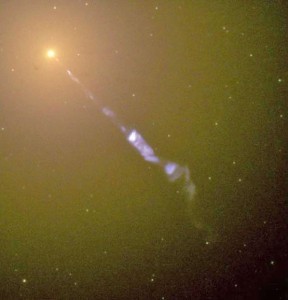Scientists Identify the Edge of a Massive Black Hole for the First Time
New data from another galaxy’s black hole allows researchers to study the “event horizon” beyond which no matter can escape
![]()

One of three telescopes to provide groundbreaking data on a distant black hole, the James Clerk Maxwell Telescope sits atop Mauna Kea in Hawaii. Photo by Nik Szymanek
The point of no return has been discovered at last. Fifty million light-years from Earth, in the heart of the Messier 87 galaxy, a black hole that is six billion times more massive than the Sun has provided scientists with the first measurement of what is known as an “event horizon,” the point beyond which matter is forever lost to the black hole.
“Once objects fall through the event horizon, they’re lost forever,” says Shep Doeleman, a research associate at the Harvard-Smithsonian Center for Astrophysics and lead author on the paper published in Science Express.
Black holes are the densest objects in the universe. “There’s such intense gravity there that it’s not just matter that can cross the event horizon and get sucked into the black hole but even a photon of light,” says co-author Jonathan Weintroub, also at the Harvard-Smithsonian Center for Astrophysics. “There’s a bit of a paradox in claiming that we’ve measured a black hole, because black holes are black. We measure light, or in our case, radiowaves” from around the black hole, not the black hole itself.
The black hole in question is one of the two biggest in the sky, according to a September 2011 paper titled, “The size of the jet launching region in M87,” which outlined how measurements of the event horizon could be taken.

Described in the paper, “Jet-Launching Structure Resolved Near the Supermassive Black Hole in M87,” these jets are made of, “relativistic particles that can extend for hundreds of thousands of light-years, providing an important mechanism for redistributing matter and energy on large scales that affect galactic evolution.” Image by NASA and Hubble Heritage Team STScI/AURA
Beyond being fantastically, mind-bogglingly bizarre, black holes are also useful targets for study, explains Weintroub, particularly the ten percent that exhibit what are known as jets, or light-emitting bursts of matter being converted into energy as masses approach the event horizon. Supported by Einstein’s general theory of relativity, these jets provided the radiation Weintroub’s team needed to take its measurements.
Using the combined data from radio telescopes in Hawaii, Arizona and California, researchers created a “virtual” telescope capable of capturing 2,000 times more detail than the Hubble Space Telescope. At this level of detail, researchers were able to measure what is known as the “innermost stable circular orbit” of matter outside the black hole as well as M87′s event horizon. If the event horizon is the door into a black hole, then the innermost stable circular orbit is like the porch; past that point, bodies will begin to spiral toward the event horizon.
“We hope to add more telescopes,” says Weintroub. “That’s really what we need to do to start to make new images and understand what the hell is going on at the base of the jet.”
As a point of clarification on what the team has actually done, Weintroub says, “I’ve seen headlines saying we made an image of the black hole–we didn’t in fact make an image of anything, and if we made an image, it would be the pattern of radiation in the immediate neighborhood of the black hole, because the black hole is black.”
While the appearance of black holes may be simple to describe (they’re black), their behavior quickly gets weird and that’s precisely the scintillating promise waiting at the event horizon.
“Black holes are interesting,” says Weintroub, “because one of the things that Einstein predicts with his theory of general relativity is that radiation bends light.” In truth, Weintroub continues, Einstein posited that the gravity of massive objects (black holes included) actually bends the space through which light travels.
As Weintroub puts it, “Gravity bends the very fabric of space, and intense gravity bends the fabric of space intensely.”
As the virtual telescope expands to other sites in Chile, Europe, Mexico, Greenland and the South Pole, Weintroub says they’ll be able to create ever more detailed images within roughly five years. “When we start making images,” he says, “we’ll be able to see whether or not the radiation that a black hole admits is ‘lensed,’” or bent, as Einstein predicted.
Meanwhile, here in the Milky Way, things are equally exciting for different reasons. Though the black hole at the center of our galaxy is what Weintroub calls “quiet” and lacks a jet, this September researchers at the Harvard-Smithsonian Center for Astrophysics discovered a gas cloud with planet-forming capabilities headed toward the Milky Way’s black hole.
/https://tf-cmsv2-smithsonianmag-media.s3.amazonaws.com/accounts/headshot/Leah-Binkovitz-240.jpg)
/https://tf-cmsv2-smithsonianmag-media.s3.amazonaws.com/accounts/headshot/Leah-Binkovitz-240.jpg)